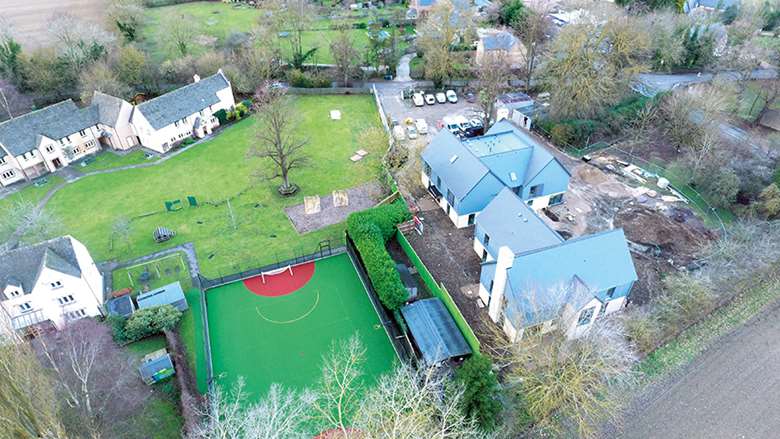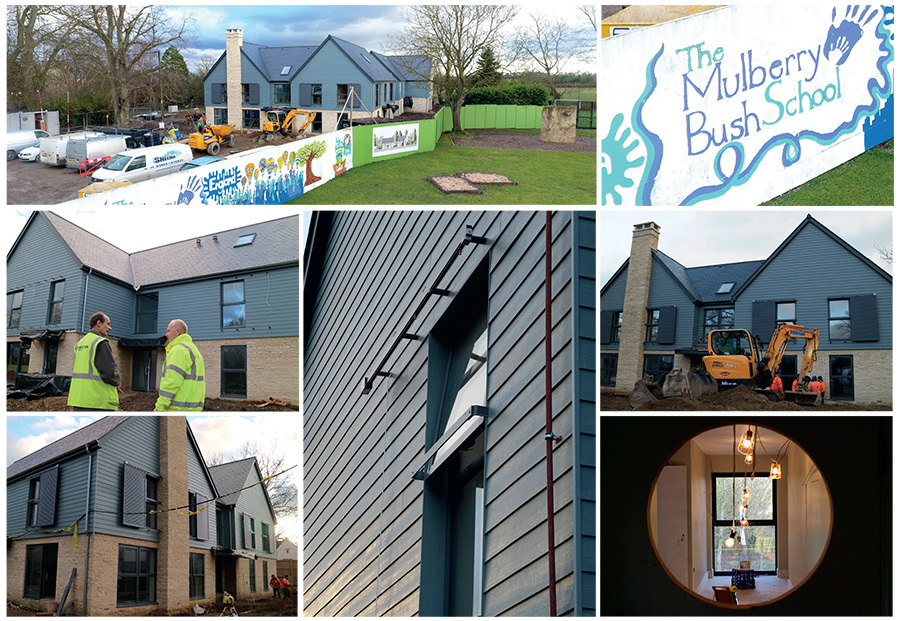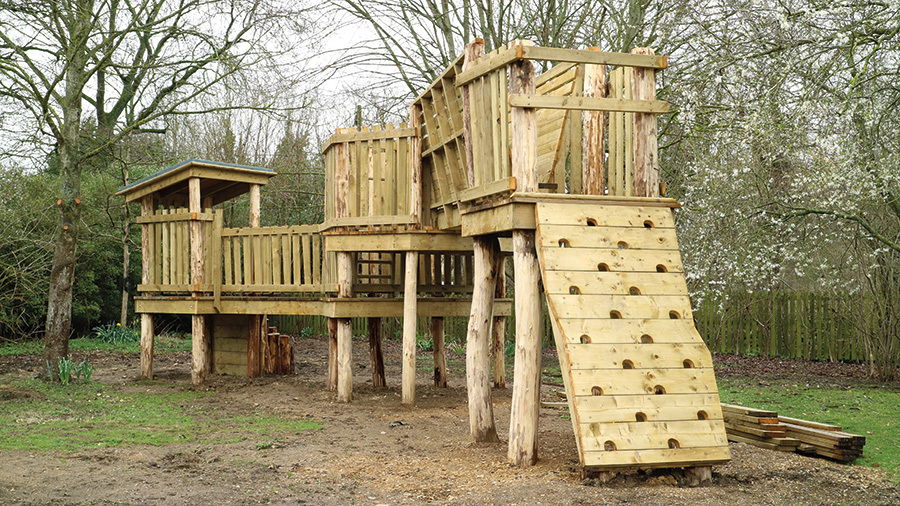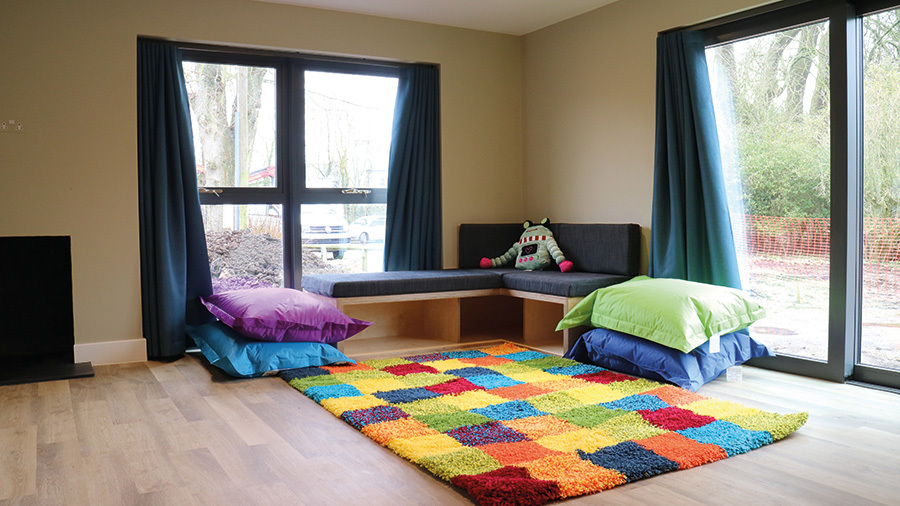Mulberry Bush: Building the Burrow
Tom de Castella
Tuesday, April 24, 2018
Residential special school Mulberry Bush is opening a new year-round unit to care for children who do not have families to return to during school holidays. Tom de Castella visits the specialist facility.

Timber panels, dark blue shutters and gabled roofs - it looks like a piece of Scandinavia dropped into the heart of rural Oxfordshire. The Burrow certainly isn't your usual country bolthole. Set to open in May half term, it is the newest part of the Mulberry Bush, a residential special school for children aged five to 13 who have severe emotional and behavioural difficulties.
Matthew* is one example of a child who has benefited from Mulberry Bush's therapeutic approach. He was adopted at a young age but his family found it impossible to look after him following a number of school exclusions. When he first arrived at Mulberry Bush he insulted and physically attacked the other children. He would run off site, climb onto roofs, and put himself in extreme danger. But as time passed he began to establish relationships with adults, made better decisions and found he did not need to run away or fight. He made friends, his self-esteem grew and he became a caring child who would support other children rather than making things harder for them. When he left Mulberry Bush, his parents said the school had "saved him and the family". They now spend time together, and he has gone on to a specialist secondary school where he is learning successfully.
Second chances
Providing second chances is what Mulberry Bush, located in the village of Standlake, Witney, excels at. But the charity has until now had to turn away one in every four children referred. Ofsted rules mean that without year-round facilities settings can only take children for up to 38 weeks. So if a child didn't have a family placement to go to during the holidays or at designated weekends, they couldn't be accepted by Mulberry Bush. Equally, if a child's family placement broke down during their time at the school, they had to leave. The unfairness of it has long bothered staff, says chief operating officer John Turberville, and is why they felt they had to build the Burrow.
Currently registered as a residential school, the setting will shortly complete the process of re-registering as a children's home. Children will not stay at the Burrow for 52 weeks of the year. During the normal school term of 38 weeks they will live in the same houses as all the other children. It is only when other children leave to see their families that those without family placements go to the Burrow.
For Claire McCarthy, head of group living at Mulberry Bush, having the option of year-round care is a no-brainer. "The children we work with are incredibly complex. The staff recognised that it would be much better for us to carry on looking after them during the holidays rather than be moving them backwards and forwards into respite provisions or short-term foster care."
The children were not involved in the design but they helped to choose the name - the Burrow is the Weasleys' house in Harry Potter. It is located on the other side of the school site known as the Village Green, a lawn watched over by a venerable lime tree. The Burrow is supposed to feel part of the school but separate from the daily routine.
"An awful lot of thought went into the design of the building," says Turberville. Architects Anderson Orr were hired to create a place that is homely, light, and perhaps most importantly, robust. For children at Mulberry Bush come with challenging behaviour. "Generally they're referred at the point that the local authority has exhausted all the resources available to them," explains Turberville. Half are fostered and have usually had between three and six placement breakdowns. Only the most dedicated of staff can cope. "Our children can be very violent - hitting, kicking, punching, biting other children and staff," says Turberville. "We have children that abscond and roof climb. One child used to burrow into electrical sockets and pee in them."

Modern style
The existing school houses are pleasant and non-institutional. But the Burrow is a notch up - stylish, light and modern. On the ground floor there is a large living room with double doors opening onto a garden with an adventure playground. Down a wide corridor is a sleek, spacious kitchen. The colour palette is a calm grey-green.
To one side of the ground floor is the Squiggle Rooms - two en suite bedrooms for visiting families. Going upstairs, the landing is bathed in light from a huge window and skylight. There's a morning room with a cosy snug and sofas where children can hang out and watch films. All six bedrooms are single as some of the children display sexually inappropriate behaviour. They are spacious and uncluttered, equipped with single bed, bedside table with a radio, chest of drawers, desk and a chair. There are curtains as well as shutters and each room is sound proofed. Many of the children have not slept a full night for years. This is why night staff "sleep in" rather than stay up, says Richard Hartwell, the Burrow's manager. The culture is that at night you go to sleep, staff included, rather than stay awake and chat.
Safety measures are subtle. Hartwell points at a wooden banister above a stairwell with a three or four metre drop. The wood is curved to prevent children walking along the top or gaining a finger hold. There are blocks under the floor in case furniture needs to be secured. There are no bars on the windows but they can only be opened a certain amount. Equally, baths shut off at a certain point to avoid flooding and all the light switches, hooks and shower curtain rails are anti-ligature. All bathrooms are wet rooms, minimising water damage. There is underfloor heating as in the past some children tried to rip radiators off the wall. In the event of a child becoming agitated it is possible to cut off the power and water to each bedroom.
Children at the school usually stay for three years. Those accommodated at the Burrow will stay there for a minimum of a term before they can move back into 38-week provision. However, they could spend their whole three years there. "It is really about trying to focus on the integration of children back into families," says Turberville. The idea is that families can come and visit children in the Burrow by staying in the Squiggle Rooms. Once a family relationship has been formed they can move back into 38-week provision. A family placement is not right for every child so a few will go on to some other form of residential care at the end of their time in the Burrow.

Placement shortage
The launch of the facility comes amid a shortage of residential placements. While there has been an increase in the number of children's homes with more privately run, for-profit homes coming into being, these are generally smaller. Meanwhile, the number of local authority-run homes continues to fall. The result is an overall drop in children's home places.
There are seemingly fewer places at residential schools too with government data showing a 16 per cent decrease since 2012 although this may be partly down to some schools - like Mulberry Bush - re-registering as children's homes.
On some days there are no children's home places available anywhere in the country, says Jonathan Stanley, chief executive of the Independent Children's Homes Association and principal partner at the National Centre for Excellence in Residential Child Care.
"Across the country children's homes get 500 referrals a month and the sector is largely full with occupancy at 85 to 95 per cent," he says. Meanwhile providers are struggling to make ends meet. "That is because of the inadequate level of fees where local authorities are imposing a zero per cent increase year on year. At the same time costs are rising year on year. And there's very tightly focused regulation."
All this means some homes find it impossible to keep going and providers are deterred from launching new provision. "Morale is also a serious issue. People are wondering whether to stay in the sector. It's a serious problem," says Stanley. In creating new provision, he describes Mulberry Bush is a "single beacon" in the country. With its "outstanding" Ofsted rating and high-quality facilities, it is perhaps better placed than most to cope with the squeeze. But it is not full, with 23 out of 31 places currently occupied.

Referral process
At Mulberry Bush a 38-week placement costs £198,000, while 52 weeks will be £255,000. The school aims to offer a local authority the same fee for the duration of a child's stay. Referrals are from England and Wales with most children coming from the Midlands and the South. The referral process takes a minimum of three weeks but usually several months. It starts with the school being approached, usually by a local authority but sometimes by a family or school. There are certain things that rule a child out. Children aged 11 or older are usually ineligible, but exceptions are made. As are children who are autistic or have a physical disability - there are other services better suited to their needs, says Turberville. The Mulberry Bush's core demographic is younger children who have attention deficit hyperactivity disorder, attachment disorders and have had trauma in the first two years of their lives. If the basics are right on that first conversation the school asks for paperwork - assessment reports, family histories, court reports, school reports. Then if the child is deemed an appropriate referral the local authority and family are encouraged to visit the school. If that goes well Mulberry Bush staff visit the local authority and there is a visit to the child at home. Finally, the child visits the school. The following week they can start. "We don't rush. We want to ensure we're the right place. We're not right for everyone," Turberville says.
Once children arrive they receive a 12-week assessment. They start in Rainbow House where they have a house manager, key worker, teacher, therapist and support from the therapies and networks team who liaise with families on the outside. Educational targets are set. The school follows the national curriculum with four classes and two foundation stages, which are more play-based. Age isn't the determining factor, the children can be in the foundation stage for three months or two years. The school follows psychodynamic principles. Repeatedly throughout the day children are asked to reflect on their feelings, learning to understand how emotion can affect behaviour, explains Hartwell.
The five-week summer holiday will be the longest period at the Burrow. "We need to let them experience being children on holiday," says Boni Delos-Santos, the Burrow's deputy manager. The plan is to take children away camping or to the beach for four or five days at a time. When they come back there will be normal family activities, such as planning meals, shopping and cooking, he says. "It's about teaching children basic life skills."
*Name changed
FACTFILE THE BURROW
What is it?
The Burrow is a purpose-built boarding house on the site of the Mulberry Bush School in Oxfordshire.
Who does it cater for?
The facility has been specially designed for children who don't have families to go to on "travel weekends" or in the holidays. Children are aged between five and 13 and have suffered trauma.
What facilities does it provide?
There are six en suite bedrooms for children and two bedrooms for "sleep in" staff. The unit also houses the Squiggle Rooms - two bedrooms for visiting families. Next door is a house for gap year students who work as volunteers at the school. The Burrow has a clearly defined boundary and separate entrance to differentiate between school time and holiday time.
How much did it cost?
Together the new facilities - the Burrow itself and accommodation for families and students - cost £3.3m.
How are children referred?
Children staying at The Burrow will be referred by local authorities or their families in the same way as any referred to the Mulberry Bush.
How is it staffed?
There will be 11 staff at the Burrow - a house manager, deputy house manager, two senior therapeutic childcare practitioners and seven therapeutic childcare practitioners.
MULBERRY BUSH TIMELINE
1948
School founded in family home - Longwood House - by pioneering psychotherapist Barbara Dockar-Drysdale aided by post-war support for traumatised children from the government
1968
Dockar-Drysdale's influential work Therapy in Child Care is published
1969
Longwood House is demolished and a new school built on the site with funds from Gulbenkian Foundation
1970
Dockar-Drysdale publishes her second major work Consultation in Child Care
1970-1980
School is run by John Armstrong and then Dr Christopher Reeves from 1980-1991
1990
Publication of Dockar-Drysdale's The Provision of Primary Experience
1995-2000
School site is developed and four independent households built
2005
New sports hall built
2007
The Mulberry Bush Outreach service is established to offer external training
2007
Launch of Mulberry Bush's Foundation Degree in Therapeutic Work with Children and Young People, accredited by the University of the West of England
2007
Achieves "outstanding" rating from Ofsted for care standards. Rated outstanding annually for care from 2007-2018 with one "good" in 2016
2011
Achieves National Support Teaching School Status
2012
The International Centre for Therapeutic Care is founded - an alliance of organisations and individuals that shares ideas and best practice about therapeutic work
2012
Achieves "outstanding" education judgment from Ofsted and same again in 2018
2016
Work started on the Burrow to extend provision to 52 weeks
2018
70th anniversary of Mulberry Bush and opening of the Burrow with the first children staying for the summer holidays




